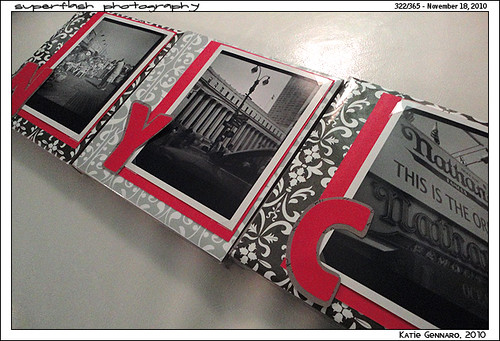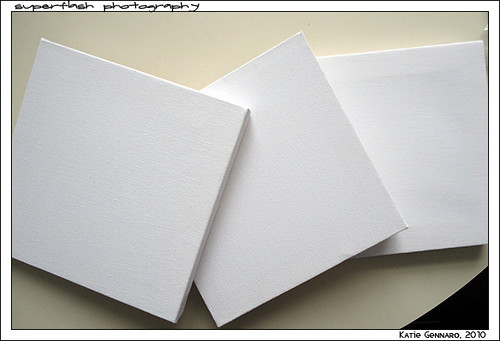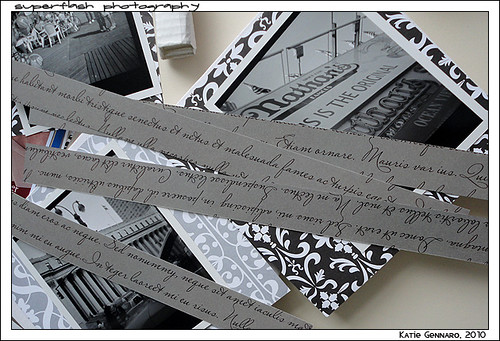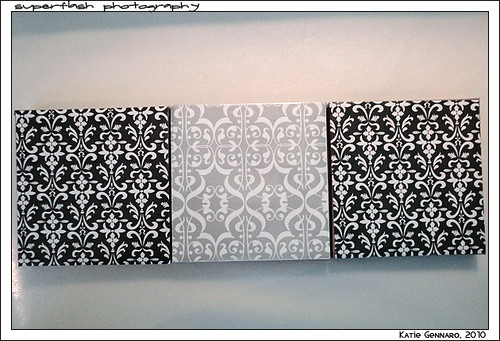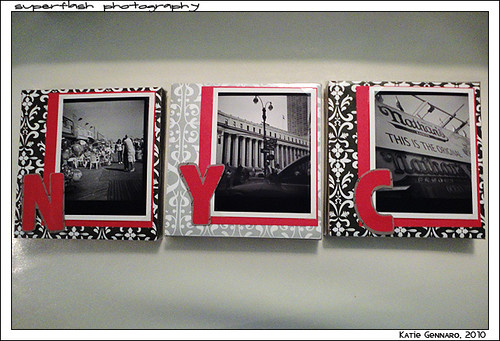Here's a tutorial for a new project I spent the day working on...
I started out wanting to make just a set of canvases for my bedroom... but as I was working, I realized that with the b&w colour palate, I could actually use these for multiple occasions, and switch them up every once in a while... and so the Interchangeable Canvas idea was born!
Materials:
- 3 canvases (I found mine in a 3 pack at the dollar store)
- scrapbook paper (I used 4 different sheets)
- double sided tape, regular tape, and glue
- photo corners
- laminating plastic (Also found this at the dollar store)
Steps:
1. Start with your blank canvases... so much potential here! Use your creativity. My bedroom happens to be black & white damask, with 3 bright fuchsia walls, and one grey wall. I had some damask paper in my collection that I had specifically bought to be some sort of bedroom decor, so I used that. Use whatever tickles your fancy, but make sure it's something that you really like, because it'll be the "permanent" part of the interchangeable canvas.
2. Gather your paper and cut down to size. My canvases were about 4 inches square, and I also cut 1 inch strips for the edges of the canvas (the 1 inch leaves a bit of overlap so that the edges look a bit smoother). The paper I chose was a black on grey Latin (I think?) script. I thought it was a nice complement, while still staying within a neutral colour scheme.
3. Apply your double-sided tape to the 1-inch strips. Expose the other side of adhesive, and stick to the edge of the canvas. I left the paper long enough to wrap around two sides, and did a traditional gift-wrapping type corner on the canvas. If you need to, you can actually use a dab of glue or even tape to help the paper stay down, because it will be covered by the main canvas paper.
4. Glue your scrapbook paper (which has already been trimmed to size) onto the canvas. I just used a regular ol' glue stick here. Cut your laminating sheet down to size (mine was about 6.5 inches square). Then, peel the backing from the sheet, and making sure you're working on a clean surface, lay it down, sticky side up, and lay your canvas, right side down, on top of it. Smooth out any bubbles, and wrap it around the edge of the canvas, all the way to the back. You can use staples into the frame of the canvas if you want to secure it a little bit more. At this point, you're pretty much done! The canvases can be hung as is, or you can add some artwork to them. I added stuff, so I'll keep going with that step...
5. So, I had some photos that I took on my last trip to NYC, with my Diana+ lomography camera... since they were shot on film (and I have no idea where the negatives are, since moving), I didn't want to glue them down, or glue anything to them. I secured them to pink scrapbook paper using photo corners, and the "N" "Y" and "C" are only glued to the scrapbook paper, not to the actual photos. The art is stuck to the canvas with just tape... and the tape peels away from the laminate easily, so whenever the mood strikes, I can change up my canvases and have some new art on my walls!
Now I just need a hammer and some nails to actually get these things up on my wall.
Like this tutorial? Try it? Leave me a note and let me know!
The online home and personal portfolio of Toronto photographer, Katie Gennaro
Friday 19 November 2010
Friday 5 November 2010
Washer Necklace
So, pretty much every blog in the craft world has done some take on the washer necklace. I recently inherited a bunch of washers from the set (yes, everyone looked at me like I was very strange when I got super excited about washers. But I'm used to everyone looking at me like I'm strange. No big deal.)... So here's my first washer necklace. I didn't take any process photos, so if anything's confusing, let me know.
Materials needed:
1 washer
hemp cord
patterned paper
mod podge
diamond glaze
1. Take your washer and trace it onto your paper, opposite side of the pattern you're using, so that the pencil doesn't show through.
2. Cut out, or if you happen to have punches that fit the sizes exactly (lucky you!) use those!)
3. Slap some mod podge down on your washer, and lay the paper (patterned side up) on top. Let it dry a bit. (If you like, you can cover the edges or the back with more patterned paper, but I like the look of the washer itself)
4. Lay on a thick coat of Diamond Glaze and let it dry (hardest part! I recommend letting it dry at least overnight, so that you don't end up with any fingerprints on your necklace).
5. Once it's dry, you can take your hemp cord and loop it through the washer. For the closing, you can add some jump rings and add a clasp, or you can do what I did, and use an adjustable sliding knot. This is my favourite, because you can change the length of your necklace depending on what you're wearing. Since I didn't take any process photos, here's a tutorial that you can follow along with.
Let me know if you end up trying this out! Or if you've already tried it, let me know if you have any tips to improve it.
Materials needed:
1 washer
hemp cord
patterned paper
mod podge
diamond glaze
1. Take your washer and trace it onto your paper, opposite side of the pattern you're using, so that the pencil doesn't show through.
2. Cut out, or if you happen to have punches that fit the sizes exactly (lucky you!) use those!)
3. Slap some mod podge down on your washer, and lay the paper (patterned side up) on top. Let it dry a bit. (If you like, you can cover the edges or the back with more patterned paper, but I like the look of the washer itself)
4. Lay on a thick coat of Diamond Glaze and let it dry (hardest part! I recommend letting it dry at least overnight, so that you don't end up with any fingerprints on your necklace).
5. Once it's dry, you can take your hemp cord and loop it through the washer. For the closing, you can add some jump rings and add a clasp, or you can do what I did, and use an adjustable sliding knot. This is my favourite, because you can change the length of your necklace depending on what you're wearing. Since I didn't take any process photos, here's a tutorial that you can follow along with.
Let me know if you end up trying this out! Or if you've already tried it, let me know if you have any tips to improve it.
Subscribe to:
Posts (Atom)
